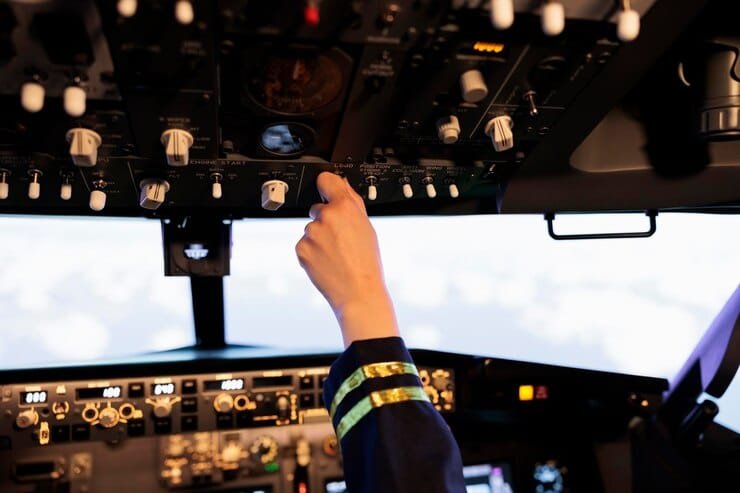Overview: Avionics Revolution: How Flying is Reshaping Electronics Forever
Alright, buckle up because we’re about to take off into the exciting world of avionics! It’s not just about dials and gauges anymore, folks. The sky is literally the limit when it comes to how aviation is pushing the boundaries of electronics innovation. Prepare for a journey that reveals how advancements in flying technology are causing a major ripple effect across the entire electronics industry.
Here’s a quick taste of what’s in store:
- More Than Just Autopilot: Gone are the days of simple flight instruments. Today’s avionics encompass complex systems, from advanced navigation and communication suites to sophisticated in-flight entertainment and real-time data analytics. We’re talking about interconnected ecosystems that are transforming how aircraft operate and how we experience flight.
- The “Smart Cockpit” Evolution: Forget clunky interfaces and confusing controls. The modern cockpit is becoming a highly intuitive, user-friendly environment, packed with touchscreens, voice controls, and augmented reality displays. This revolution demands smarter, more reliable electronics that can handle the processing power of this level of integration.
- Safety, Safety, Safety (and Efficiency!): The relentless pursuit of safer skies is the biggest driver of innovation in avionics. New technologies are boosting navigational accuracy, collision avoidance, and overall operational safety. Plus, these systems are also optimized for efficiency, reducing fuel consumption and minimizing environmental impact – it’s a win-win!
- The Sky’s the Limit for Electronics Materials: The extreme environments of flight – think extreme temperatures, high altitudes, and constant vibrations – require highly specialized materials. This is forcing electronics manufacturers to create components that are smaller, lighter, more robust, and more energy-efficient than ever before. And trust us, those innovations often spill over into other applications back on earth.
- Beyond the Plane: Spinoff Effects: It’s not just about what’s happening inside the aircraft. Avionics advances are trickling down into other industries, from drone technology and autonomous vehicles to even medical devices. This is a true testament to the groundbreaking power of aerospace electronics.
This blog post will explore these key trends, diving deeper into the specific technologies, challenges, and opportunities that are reshaping the electronics landscape thanks to the power of flight. So, get ready to learn how avionics is not just about flying, it’s about driving the future of electronics.

Positive Trends
- The Rise of Connected Aircraft (aka “Flying IoT”): Trend: Increased connectivity via satellite and terrestrial networks is transforming aircraft into data-generating powerhouses. Impact: Opens doors for predictive maintenance, enhanced passenger experiences (think personalized in-flight entertainment and real-time flight updates), and more efficient flight operations. Example: Companies like Collins Aerospace are developing advanced connectivity solutions to tap into this trend. Actionable Insight: Invest in data analytics and cloud-based platforms to process and leverage the growing influx of aircraft data.
- Autonomous Flight & Advanced Air Mobility (AAM): Trend: The dream of pilotless aircraft and urban air taxis is becoming increasingly real. Impact: Massive growth potential in drone technologies, advanced navigation systems, and new air traffic management solutions. Example: Companies like Joby Aviation and Wisk Aero are pioneers in the AAM space, showcasing future possibilities. Actionable Insight: Explore research & development in autonomy and AAM technologies, or collaborate with companies already leading in those spaces. Be an early bird to catch the worm.
- Sustainability & Greener Aviation: Trend: Pressure to reduce emissions is driving innovation in electric propulsion, sustainable aviation fuels (SAF), and optimized flight paths. Impact: Demand for eco-friendly avionics, such as lighter materials and more efficient power management systems, is soaring. Example: Airbus is experimenting with hybrid-electric aircraft, demonstrating the industry’s push towards sustainability. Actionable Insight: Invest in R&D focusing on sustainable solutions, both materials and software. Highlight these green credentials to appeal to increasingly eco-conscious airlines and passengers.
- Digital Cockpits & Enhanced Pilot Interfaces: Trend: Legacy analog systems are making way for intuitive digital cockpits, featuring touchscreens, augmented reality (AR) displays, and advanced flight management software. Impact: Improved pilot awareness, reduced workload, and enhanced safety. Example: Garmin’s G1000 integrated avionics suite is an example of the transition to user-friendly digital interfaces. Actionable Insight: Focus on creating intuitive, user-centric cockpit interfaces that are easy to adopt and enhance overall pilot efficiency.
Adverse Trends
- Supply Chain Vulnerabilities: Trend: Global disruptions (like pandemics and geopolitical tensions) expose the fragility of the avionics supply chain, leading to component shortages and production delays. Impact: Increased costs, longer lead times, and potential delays in aircraft deliveries. Actionable Insight: Diversify your supply chain, build buffer stocks, and explore local sourcing options to mitigate risks.
- Cybersecurity Threats: Trend: Increased connectivity also makes aircraft more vulnerable to cyberattacks. Impact: Potential for system malfunctions, data breaches, and disruption of flight operations. Actionable Insight: Prioritize cybersecurity investments and adopt a “security by design” approach to build robust and resilient systems. Develop robust cybersecurity strategies with regular audits and training.
- Regulatory Complexity: Trend: The rapidly evolving technology landscape requires continuous updates to aviation regulations, creating challenges for manufacturers to remain compliant and obtain timely certifications. Impact: Increased time-to-market for new products, higher development costs, and bureaucratic hurdles. Actionable Insight: Foster strong relationships with regulatory bodies, invest in compliance resources, and be proactive in adapting to new guidelines. Keep your fingers on the pulse with regulatory changes, be an early adopter.
- Skills Gap: Trend: There’s a growing demand for skilled engineers and technicians specializing in advanced avionics technologies. Impact: Potential labor shortages, increased competition for talent, and pressure on salaries. Actionable Insight: Invest in training programs, partner with educational institutions, and attract talent with competitive packages and a clear career path. Make it exciting to join your team!
By understanding and acting on these trends, companies in the avionics market can chart a successful course through the ever-changing skies. So, keep your eyes on the horizon, and happy flying!
* Precision Agriculture: Avionics-derived GPS and inertial navigation systems are used in agricultural drones for precise crop spraying, mapping, and health monitoring. This allows farmers to optimize resource allocation, reduce waste, and improve yields by targeting specific areas needing attention, resulting in higher profitability and more sustainable practices. Businesses can leverage this for drone services, data analytics, and specialized agricultural hardware.
- Emergency Medical Services: Helicopters equipped with advanced avionics systems, including weather radar and night vision, can reach accident scenes quickly and safely in adverse conditions. Real-time tracking and communication systems also allow for better coordination between the aircraft and ground teams, maximizing the chances of survival for patients. Companies can look into creating integrated hardware and software solutions to manage these complex operations.
- Automotive Testing and Development: Automotive manufacturers utilize avionics-grade sensors and inertial measurement units (IMUs) for precise vehicle testing and validation. These sensors provide high-accuracy data on vehicle dynamics, crucial for developing advanced driver-assistance systems (ADAS) and autonomous driving technologies. Businesses can provide specialized test equipment, data analysis services, and consulting for this market.
- High-Precision Manufacturing: Avionics-inspired control systems, including sophisticated sensors and data analysis tools, are incorporated into automated production lines for manufacturing high-precision parts. These systems ensure accurate placement and assembly of components, minimizing defects and improving overall production efficiency. This could represent opportunities for control system design, predictive maintenance solutions, and data-driven insights for manufacturers.
- Renewable Energy Monitoring: Drones equipped with specialized avionics sensors and cameras are used for inspecting wind turbine blades and solar panel arrays. These sensors can detect structural damage, thermal hotspots, or other problems early, allowing for timely maintenance and preventing costly repairs. This is a good area for businesses specializing in inspection and maintenance services, as well as drone technology for renewable energy infrastructure.
- Oil and Gas Pipeline Inspection: Avionics technology, specifically lidar and infrared sensors integrated into UAVs, is used for remote pipeline monitoring and leak detection. This provides a much safer and cost-effective alternative to manual inspections. Businesses can explore UAV-based inspection and monitoring solutions specifically targeting the oil and gas industry.
* Focus on Sustainable Aviation Technologies: Companies are aggressively investing in research and development of sustainable technologies, such as electric and hybrid-electric propulsion systems. For example, in 2023, multiple avionics manufacturers partnered with airframe companies to develop and test advanced power management systems optimized for electric aircraft, aiming to reduce emissions and operational costs. This reflects a significant push towards meeting future environmental regulations and demands.
- Adoption of Open Architectures: A key strategy is the shift towards modular and open architecture systems. This allows for easier integration of new technologies and reduces dependency on proprietary solutions. Companies like Collins Aerospace, have been promoting open standards in their avionics suites, allowing for greater flexibility and interoperability. This fosters a more competitive landscape and accelerates innovation through shared development platforms.
- Strategic Acquisitions for Technology Expansion: Inorganic growth is being pursued through strategic acquisitions. For instance, a leading avionics firm may acquire a smaller company specializing in AI-powered predictive maintenance software to quickly integrate advanced capabilities into their existing offerings. This allows for rapid capability expansion and diversification into new market segments, rather than solely relying on organic growth.
- Cybersecurity Investments: With increasing reliance on digital systems, avionics companies are significantly boosting investments in cybersecurity solutions. Enhanced firewalls, intrusion detection systems and robust data encryption are becoming standard offerings. Post 2023, many firms have established dedicated cybersecurity divisions and are partnering with specialists to ensure they meet the latest security standards.
- Data Analytics and AI Integration: There’s a growing emphasis on leveraging data analytics and artificial intelligence. Companies are using AI to improve flight planning, enhance predictive maintenance, and optimize air traffic management. Post 2023, firms are developing AI tools that can analyze vast amounts of flight data to identify performance trends, potential safety issues, and ways to reduce fuel consumption.

Outlook & Summary
The avionics revolution isn’t just a blip on the radar; it’s a full-blown paradigm shift that’s set to redefine the entire aerospace electronics landscape. Here’s what to expect in the next 5-10 years:
- Increased Autonomy, Not Just for Drones: We’re moving beyond basic autopilot. Expect to see increasingly sophisticated AI-driven flight management systems that handle more complex situations, potentially reducing pilot workload and enhancing safety. Think of it as turning the “auto” dial up to 11.
- Data, Data Everywhere (and Being Used): The amount of data generated during flights will explode. This means advanced analytics will be vital for everything from predictive maintenance to optimizing fuel consumption – and yes, maybe even understanding why your seatmate keeps hogging the armrest.
- Seamless Integration is Key: The trend towards more integrated systems – think avionics seamlessly communicating with cabin management, ground support, and even passengers’ devices – will become the norm. No more siloed tech; it’s all about smooth connectivity.
- A Shift in Materials: Lighter, more durable, and energy-efficient materials will dominate the design and production of avionics hardware, leading to weight savings and cost reductions. Think of this as going on a crash diet, but for aircraft components.
- Broader Market Impact: While avionics are at the heart of this transformation, the ripples extend to the entire aerospace electronics sector. The innovations driven in aircraft cockpit & systems are finding their way into everything from satellite tech to drone development, truly a cross-industry evolution.
Key Takeaway: Avionics is not just evolving; it’s driving a transformative change that promises safer, more efficient, and data-rich air travel. This isn’t a “set it and forget it” situation; it demands continuous innovation and a proactive approach. The benefits, however, are undeniable.
So, with all this change on the horizon, are you ready to navigate the next chapter of the avionics revolution?


